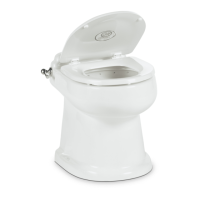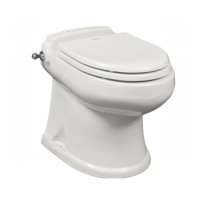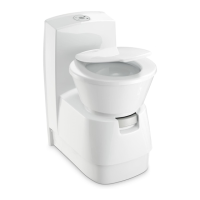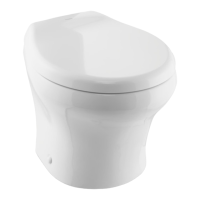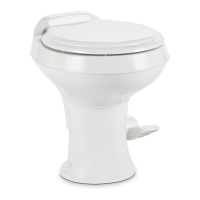9
EN
Full Ceramic Gravity Discharge Toilet Troubleshooting
6.1 Troubleshooting Guide
Operational Issue Possible Cause Remedy
The toilet will not flush
and water will not enter
the toilet bowl.
The fuse is blown or the
circuit breaker is tripped.
• Check the toilet fuse or circuit breaker at the DC distribution panel.
• Check for loose/defective wiring between the power source and the
toilet (terminal block pins 5 and 8, for 4300 and 4400 series).
• Check for reverse polarity of the incoming power.
• For 4300 and 4400 series: check for a defective diode D1 at pin 5 of the
terminal block.
The toilet will not flush,
but water enters the
toilet bowl.
There is an electrical or
mechanical failure related to
the flush valve.
• Check for loose/defective wiring between the flush switch and the toilet
(terminal block pins 2 and 3, for 4300 and 4400 series).
• Check for a defective flush switch. Replace if necessary.
• Check for loose flush ball motor wires (terminal block pins 2 and 8, for
4300 and 4400 series).
• Check for a defective flush ball motor. Replace if necessary.
• Check for a motor drive arm failure. Replace if necessary. Refer to section
"7.7 Replacing the Motor Drive Arm" on page 13.
• Check for a drive linkage failure. Replace if necessary. Refer to section
"7.8 Replacing the Drive Linkage" on page 13.
The toilet flushes, but
water does not enter
the toilet bowl.
The water supply is blocked
or there is an electrical
failure.
• Check for a blockage in the water line to the toilet. Remove the line and
clear the blockage.
• Check for a clog in the filter screen at the water valve inlet. Remove the
water line and clear the debris.
• Check for loose or defective wiring between the water valve and toilet
(terminal block pins 1 and 8, for 4300 and 4400 series).
• Check for a defective water valve. Replace if necessary.
Water does not enter
the toilet bowl when
the flush handle or the
wall switch is in the
“Add Water” position.
There is an electrical
connection failure.
• Check for loose or defective wiring between the flush switch and toilet
(terminal block pins 1 and 3, for 4300 and 4400 series).
• Check for a defective flush switch. Replace if necessary.
The water will not shut
off and causes the toilet
bowl to overflow.
There is a water valve failure. • Check for debris in the water valve.
• Check for a defective water valve. Replace if necessary.
The flush ball
constantly cycles
between the open and
closed position.
There is a component
adjustment required or a
component is defective.
• Check the cam switch for adjustment. Refer to section "7.1 Aligning the
Cam Switch/Flush Ball" on page 11.
• Check for a defective cam switch. Replace if necessary.
• Check for defective drive linkage. Replace if necessary. Refer to section
"7.8 Replacing the Drive Linkage" on page 13.
• Check for shorted wiring between the flush switch and toilet (terminal
block pins 2 and 3, for 4300 and 4400 series).
• Check for a defective flush switch. Replace if necessary.
The flush ball opens
slowly or will not open
when the manual flush
lever is pressed.
A component adjustment
is required or there is a
defective component.
• Check for a defective flush spring assembly. Replace if necessary.
• Check for excessive drag between the flush ball and the flush ball seal.
Lubricate the flush ball and seal it with silicone spray.
The flush switch must
be held in the “Flush”
position to close the
flush ball.
There is a defective electrical
component.
• Check for loose or defective wiring (for 4300 and 4400 series, check
between the cam switch and terminal block pins 2, 3, and 6).
• Check for a defective cam switch.

